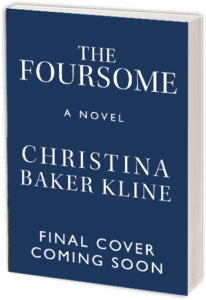William Faulkner used to map his stories on his office wall. If you visit his home in Oxford, Mississippi, you can still see the notes for his novel in his precise, small handwriting. When Laura Schenone was writing her memoir, The Lost Ravioli Recipes of Hoboken, she kept photos of her Genovese great grandmother, Adalgisa, propped on her desk, and Adalgisa’s handmade rolling pin nearby. Edwidge Dandicat has an evolving bulletin board in her workspace where she tacks up collages of photos of Haiti and images from magazines.
For many writers, visual and tactile stimulation is an important component of the creative process. I, too, have a bulletin board covered with images that change with each book I write. Recently I retired a tattered newspaper clipping that had been tacked to the wall in my office for eight years — except for the times I brought it with me to writers’ colonies or on family vacations (under the delusion that I might actually get work done on a beach).
 More than a decade ago, leafing through The New York Times, I came across this image as I was beginning to work on a new novel. I assume that it was part of an advertisement, but I cut it out carefully around the edges, so I don’t know for sure. I don’t even know when it appeared in the paper, though from what I’ve deduced from articles on the back side it seems to have been some time in the spring of 1998. (An ad for a wine store says “Prices effective through April 30, 1998.”)
More than a decade ago, leafing through The New York Times, I came across this image as I was beginning to work on a new novel. I assume that it was part of an advertisement, but I cut it out carefully around the edges, so I don’t know for sure. I don’t even know when it appeared in the paper, though from what I’ve deduced from articles on the back side it seems to have been some time in the spring of 1998. (An ad for a wine store says “Prices effective through April 30, 1998.”)
The image floored me. I had begun writing about a young couple, Ben and Claire, both expatriates living in England, who befriend another American named Charlie … who falls in love with Claire. Who may or may not be falling in love with him. This picture in the newspaper, it seemed to me, perfectly encapsulated the complexity of my characters’ situation.
For many reasons, the story this photo tells is intriguing. A couple on a park bench sits close together, facing away from the viewer. The man has his arm around the woman’s back, his hand resting protectively on her shoulder. The woman’s arm is around his shoulder, as well … except that it isn’t. It extends along and behind the bench, and her open palm rests on the hand of a man on the other side, who kisses it tenderly. (A two-sided park bench? I don’t think I’ve ever seen one in real life.)
All the markers of romantic Paris – the French restaurant awning, the folded newspaper (Le Monde), the European car in the background and baroquely detailed (if blurry) streetlight in the foreground, a smattering of fat pigeons, even the man’s black turtleneck and the woman’s plaid skirt and sensible heels – contribute to the illicit thrill of this image.
Does the man on the other side of the bench have any idea that his girlfriend/wife is being unfaithful? Did she and the man kissing her hand plan to meet at this place, or was it happenstance? For that matter, do they know each other, or is this a spontaneous moment of anonymous passion? Did the photographer happen on this scene, or was he, perhaps, hired by the man with his back to us on the bench?
The image is shocking in its seeming casualness, in the brazen, in-broad-daylight transgression taking place before our eyes. I was fascinated by the contradictions: the woman so clearly part of a couple, yet making herself available to the man behind her, her demure pose contrasting with her open, searching palm. The man’s body language, too, is contradictory; he sits casually reading the paper, one leg crossed over the other, but his eyes are closed in passion as he kisses the woman’s palm.
Instinctively I knew that this image would help me access the core motivations of my characters, who act in comparably indiscreet and scandalous ways. Claire loves her husband, but she feels something entirely different for Charlie – a passion she’s never felt. Charlie respects Ben, but is blinded by his love for Claire. And when Claire’s best friend from childhood, Alison, comes to visit and ends up engaged to Charlie, things spin even further out of control.
This novel, now in bookstores, is called Bird in Hand. When I sent the final manuscript to my publisher about six months ago I took the faded newspaper clipping down and put it in a cardboard box, along with my handwritten first draft of the novel. Now my bulletin board is covered with postcards from the New York tenement museum depicting the interior of an immigrant Irish family’s cramped apartment, a black and white photograph of a young couple at Coney Island in the 1920s, a map of the village of Kinvara, Ireland, and other inspiration for my new novel-in-progress.
This essay, in a slightly different form – and with a larger version of the newspaper clipping – originally appeared in In This Light.
